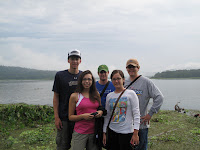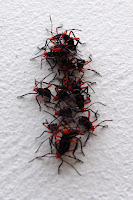Most of the work done today was about concluding all of the projects set up around Boquete. We started out the morning with a drive up Volcan Baru with Professor Hubbell and Professor Gowaty to the entrance of the national park where we hung the baits on Sunday. The drive up the hill was as bad or worse than the one on Sunday; both of the cars ended up getting stuck at some points. It looked as though some of the more solid parts of the trail had been washed out by yesterday's rain, leaving large holes among the rocks that made up the trail.


Before taking down the baits, we made another collection for Professor Hubbell. He instructed us to separate and each take a bag into the forests off the path to collect the leaves of 20 different woody plants. We took these leaves back to our cottage and separated them out, identifying them morphologically as species, and then counted the number of each type. From this data we calculated the fisher's alpha value for woody plants in the area to be 15.8, indicating a high level of species diversity.
As for the baits up on Volcan Baru, we were able to collect six out of the seven baits; one of them was missing. We think that it was probably taken down by someone walking by, rather than being taken by some animal, because the bait, string and flag were all gone. Of the other six traps, two of them had no flies, and the other four contained very few flies, much less than in the traps set in Gamboa.
Once we collected the baits, we came down the mountain, dropped off Professor Hubbell and Professor Gowaty and then went down to the Chiriqui river to collect the baits set up there. Of the four traps hung down there, only three remained. One of them had been taken down by someone passing by. Though the other three were still there, only one of them had any substantial number of flies.
Sorting and keying flies later that evening.
















































